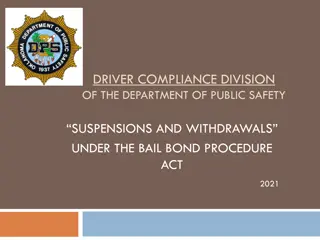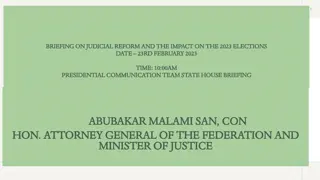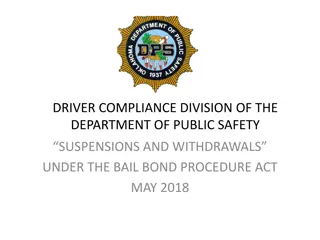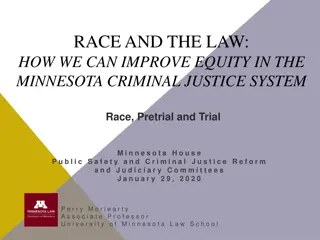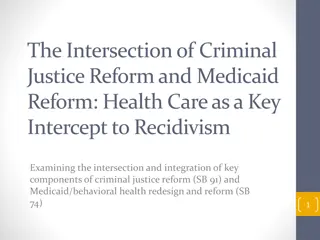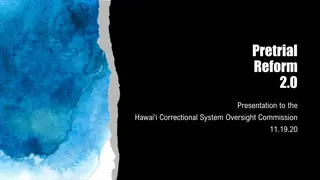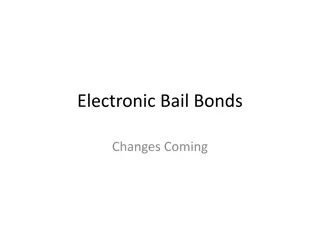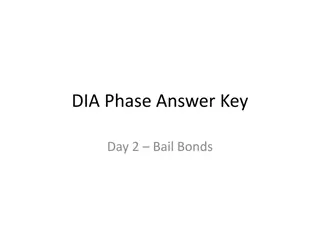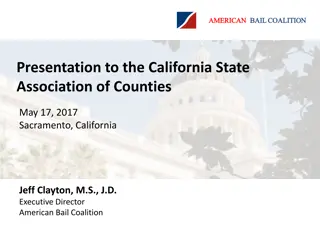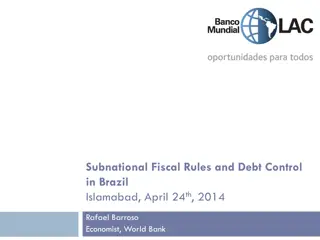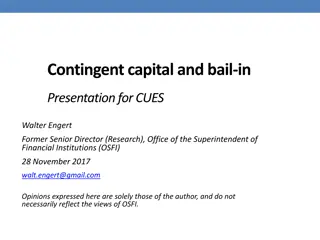Bail Reform: The New York Experience and Impact
Highlighting the bail reform efforts in New York, this content showcases the key goals, original reforms, amended reforms, and the statewide results. By aiming to reduce pretrial detention, mitigate the criminalization of poverty, curtail racial inequity, and promote public safety, New York's reform journey provides insights into the changes made, their effects, and the ongoing discussions surrounding the effectiveness of these measures.
Uploaded on Oct 08, 2024 | 0 Views
Download Presentation

Please find below an Image/Link to download the presentation.
The content on the website is provided AS IS for your information and personal use only. It may not be sold, licensed, or shared on other websites without obtaining consent from the author.If you encounter any issues during the download, it is possible that the publisher has removed the file from their server.
You are allowed to download the files provided on this website for personal or commercial use, subject to the condition that they are used lawfully. All files are the property of their respective owners.
The content on the website is provided AS IS for your information and personal use only. It may not be sold, licensed, or shared on other websites without obtaining consent from the author.
E N D
Presentation Transcript
Bail Reform The New York Experience Michael Rempel Data Collaborative for Justice at John Jay College Contact: mrempel@jjay.cuny.edu Presented at: The 17th Annual Harry Frank Guggenheim Symposium on Crime in America at John Jay College: Justice at the Crossroads: Is the Reform Window Closing? March 3, 2022
2 Key Goals of Bail Reform 1. Reduce Pretrial Detention Eliminate the detention option for some charges and/or set more stringent legal standards to justify detention. 2. Mitigate the Criminalization of Poverty Eliminate or limit the role of money in who can gain pretrial liberty. 3. Curtail Racial Inequity Mitigate the disproportionate detention of Black & Brown people. 4. Promote Public Safety Achieve above goals while maintaining or increasing safety. Data Collaborative for Justice datacollaborativeforjustice.org
3 New York s Original Reforms (Implemented January 1, 2020) 1. Partial Elimination of Money Bail & Pretrial Detention Most misdemeanors & nonviolent felonies become bail-ineligible. 2. Supervised Release Courts must be able to order pretrial supervision in any case. 3. Consideration of Ability to Pay Courts must consider individual financial circumstances if setting bail. 4. Presumption of Release Courts may not set any conditions absent evidence of risk of flight. 5. Least Restrictive Condition When justified based on flight risk, conditions must also be the least restrictive necessary for assuring return to court. Data Collaborative for Justice datacollaborativeforjustice.org
4 New York s Amended Reforms (Implemented July 2, 2020) 1. Increased Bail-Eligibility Some cases made bail-eligible again; but most misdemeanors & nonviolent felonies remain bail-ineligible. 2. Enlarged Menu of Non-Monetary Conditions Courts can order treatment & other pretrial conditions. Data Collaborative for Justice datacollaborativeforjustice.org
5 Reduced Bail & Detention: Statewide Results to Date Statewide Findings:From 2019 to 2020, bail-setting declined for all charges (Lu et al., forthcoming in 2022). All Cases: 12 percentage-point reduction. Felonies: 25 percentage-point reduction. Data Collaborative for Justice datacollaborativeforjustice.org
6 Reduced Bail & Detention: NYC Reduced Bail in 2020 (New York City Results) Remand Bail Supervised Release ROR 100% 34% 35% 80% 51% 67% 2% 60% 14% 89% 89% 12% 40% 60% 48% 19% 20% 35% 3% 14% 8% 8% 4% 4% 2019 3% 2% 2019 1% 0% 2019 2020 2020 2020 Misdemeanor Nonviolent Felony Violent Felony Source: Rempel & Weill (2021). Data Collaborative for Justice datacollaborativeforjustice.org
7 More Bail After Midyear 2020: NYC 2019 vs. 2020 NYC results (allude to statewide results; NVFOs) Percent of Cases Facing Bail or Remand Misdemeanor Nonviolent Felony Violent Felony Increased bail- setting begins May 2020 Bail reform implementation 80% 70% Pandemic begins 60% 50% 40% 30% 20% 10% 0% Jan19 Mar19 May19 Jul19 Sep19 Nov19 Jan20 Mar20 May20 Jul20 Sep20 Nov20 Source: Rempel & Weill (2021). Data Collaborative for Justice datacollaborativeforjustice.org
8 Role of the Amended Reforms: NYC Percent of Bail Cases:18% of bail & remand cases in second half 2020 were due to the amendments. Key Charges: Just two provisions accounted for about 85% of bail cases due to the amendments: 23% Burglary 2o: Harm to Person or Property: 62% Data Collaborative for Justice datacollaborativeforjustice.org
9 Why Bail Increased Midyear 2020 (though remaining lower than 2019) Bail Amendments? Lack of Training / Reversion to the Mean? Violent Crime Fears? Data Collaborative for Justice datacollaborativeforjustice.org
10 Little Change in Affordability: NYC Felony Bail Payment 2019 (N = 8,710) 2020 (N = 6,745) 60% 48% 45% 50% 40% 30% 17% 15%*** 20% 10% 0% At Arraignment Within 30 Days * p < .05 ** p < .01 *** p < .001 Source: Rempel & Weill (2021). Data Collaborative for Justice datacollaborativeforjustice.org
11 Mixed Effects on Racial Disparities The Black-White Disparity in Judges' Bail or Remand Decisions (NYC) Violent Felonies All Cases 7% 1/1/2019-3/31/2019 5% 7% 1/1/2020-3/16/2020 2% 6% 3/17/2020-7/1/2020 2% 17% 7/20/2020-9/30/2020 4% 21% 10/1/2020-12/31/2020 3% 0% 5% 10% 15% 20% Note: In cases of people charged with a violent felony in the fourth quarter, judges set bail or remand for 61% of Black, 52% of Hispanic/Latinx, and 41% of white individuals. Source: Rempel & Weill (2021). Data Collaborative for Justice datacollaborativeforjustice.org
12 Increase in Judicial Consistency Caveat: Significant judge-to-judge inconsistency persisted in violent felonies remaining eligible for bail. 2020: Judges ranged widely from setting bail in 23% to 71% of NYC violent felonies. Data Collaborative for Justice datacollaborativeforjustice.org
13 Impact on Crime & Recidivism? 1. Key Unanswered Question There has yet to be a rigorous study comparing recidivism among similar 2019 and 2020 cases; policymakers need such a study. 2. Expectation: Bail reform will not increase recidivism In 2020 & 2021, shootings & homicides increased nationally, making COVID-19 the most compelling explanation. (E.g., over a dozen major U.S. cities had 2020 homicide increases exceeding NYC.) Prior bail reform evaluations show no effect on recidivism (e.g., in studies of New Jersey, Chicago, & Philadelphia). Prior research links detention to modestly higher recidivism (e.g., in studies in NYC, Philadelphia, Pittsburgh, Miami, Houston, & Kentucky). 3. Method: Both Pretrial & Subsequent Recidivism Data Collaborative for Justice datacollaborativeforjustice.org
14 Some Takeaways on NY s Reform Significant reduction in bail & detention i.e., progress on the primary goal of reform. BUT: Bail-setting partially re-increased since midyear 2020. Significant reduction in judicial inconsistency. Implementation Deficits: Little evidence courts are considering ability to pay. Mixed effects on racial disparities. Deficit of clear decision guidelines / ongoing judicial inconsistency in bail-setting on violent felonies. Urgent need for valid research on the bail-crime relationship (to replace unsupported claims). Data Collaborative for Justice datacollaborativeforjustice.org




